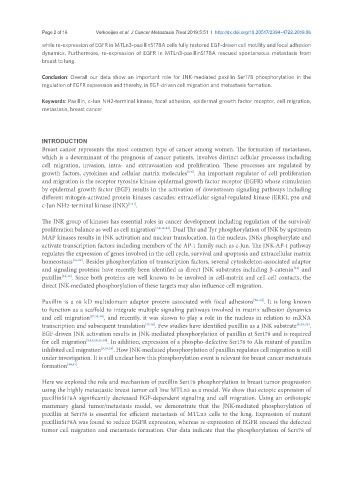Page 373 - Read Online
P. 373
Page 2 of 16 Verkoeijen et al. J Cancer Metastasis Treat 2019;5:51 I http://dx.doi.org/10.20517/2394-4722.2019.06
while re-expression of EGFR in MTLn3-paxillinS178A cells fully restored EGF-driven cell motility and focal adhesion
dynamics. Furthermore, re-expression of EGFR in MTLn3-paxillinS178A rescued spontaneous metastasis from
breast to lung.
Conclusion: Overall our data show an important role for JNK-mediated paxillin Ser178 phosphorylation in the
regulation of EGFR expression and thereby, in EGF-driven cell migration and metastasis formation.
Keywords: Paxillin, c-Jun NH2-terminal kinase, focal adhesion, epidermal growth factor receptor, cell migration,
metastasis, breast cancer
INTRODUCTION
Breast cancer represents the most common type of cancer among women. The formation of metastases,
which is a determinant of the prognosis of cancer patients, involves distinct cellular processes including
cell migration, invasion, intra- and extravasation and proliferation. These processes are regulated by
growth factors, cytokines and cellular matrix molecules . An important regulator of cell proliferation
[1-6]
and migration is the receptor tyrosine kinase epidermal growth factor receptor (EGFR) whose stimulation
by epidermal growth factor (EGF) results in the activation of downstream signaling pathways including
different mitogen-activated protein kinases cascades: extracellular signal-regulated kinase (ERK), p38 and
c-Jun NH2-terminal kinase (JNK) [7-11] .
The JNK group of kinases has essential roles in cancer development including regulation of the survival/
proliferation balance as well as cell migration [7,9,12,13] . Dual Thr and Tyr phosphorylation of JNK by upstream
MAP kinases results in JNK activation and nuclear translocation. In the nucleus, JNKs phosphorylate and
activate transcription factors including members of the AP-1 family such as c-Jun. The JNK-AP-1 pathway
regulates the expression of genes involved in the cell cycle, survival and apoptosis and extracellular matrix
homeostasis [14-22] . Besides phosphorylation of transcription factors, several cytoskeleton-associated adaptor
and signaling proteins have recently been identified as direct JNK substrates including β-catenin and
[23]
paxillin [24,25] . Since both proteins are well known to be involved in cell-matrix and cell-cell contacts, the
direct JNK-mediated phosphorylation of these targets may also influence cell migration.
Paxillin is a 68 kD multidomain adaptor protein associated with focal adhesions [26-31] . It is long known
to function as a scaffold to integrate multiple signaling pathways involved in matrix adhesion dynamics
and cell migration [27,31-36] , and recently, it was shown to play a role in the nucleus in relation to mRNA
transcription and subsequent translation [37,38] . Few studies have identified paxillin as a JNK substrate [8,24,25] .
EGF-driven JNK activation results in JNK-mediated phosphorylation of paxillin at Ser178 and is required
for cell migration [9,13,19,25,39] . In addition, expression of a phospho-defective Ser178 to Ala mutant of paxillin
inhibited cell migration [9,19,24] . How JNK-mediated phosphorylation of paxillin regulates cell migration is still
under investigation. It is still unclear how this phosphorylation event is relevant for breast cancer metastasis
formation [40,41] .
Here we explored the role and mechanism of paxillin Ser178 phosphorylation in breast tumor progression
using the highly metastastic breast tumor cell line MTLn3 as a model. We show that ectopic expression of
paxillinS178A significantly decreased EGF-dependent signaling and cell migration. Using an orthotopic
mammary gland tumor/metastasis model, we demonstrate that the JNK-mediated phosphorylation of
paxillin at Ser178 is essential for efficient metastasis of MTLn3 cells to the lung. Expression of mutant
paxillinS178A was found to reduce EGFR expression, whereas re-expression of EGFR rescued the defected
tumor cell migration and metastasis formation. Our data indicate that the phosphorylation of Ser178 of

